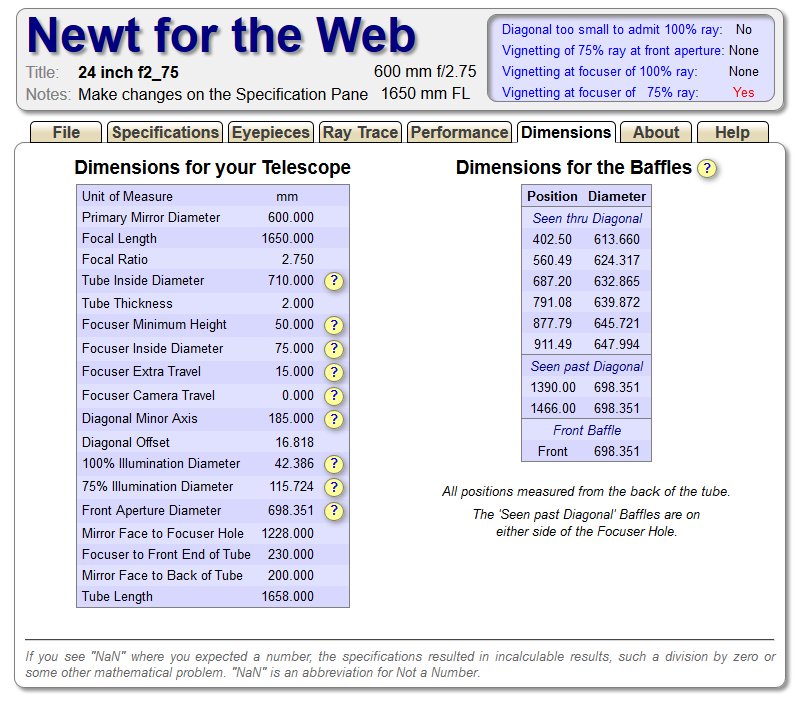|
Advertisement / Annons: |
My astronomy project:
|
|
Page:
Part: |
|
1: Introduction
Note: A member on a Swedish forum discuss a lot of a big Dobson telescope he want to build. We are talking about a huge 24" f/2.75 Newton. This telescope will only be used for visual observations, but with heavy demands on it. It shall be light and strong with carbon fiber parts. It must have a big corrected field to accept a 100 degree eyepiece. I'm not very interested in visual observations, but still this sounds exiting how to find or make a telescope like this. I thought, can I be of some help with the Newt-Web tools I'm exploring now? Yes, I think I can do that and found the basic construction of that telescope. To get correct pupil size with this telescope he want to use a Ethos or Nikon eyepiece with 17 mm focal length and 100 degree apparent field. A fast calculation by me show that the field diameter then will be about 42 mm.
After reading in the data sheet I see they say the effective field stop will be about 30 mm. There is also a need of a high quality coma corrector. He has two suggestions. Either a 3" Paracorr 2 or the smaller 2" version if the telescope can be optimized to take that without vignetting.
With that I have enough information to make a first step, it will not include the coma corrector, that come later.
|
2: Setup specification, Ray trace and dimensionThis first step is just a rough estimate. 
Here are the input data that I have used. Based on a focuser with 50 mm build height and 75 mm opening (3"), I think it will be hard to have a 2" focuser without get to much vignetting, but to be sure I will do a test later. I have laid the focus plane 15mm outside the focuser's top according to the recommendation of the program. You may need to fit a 3" to 2" reducer and then maybe this distance change, but it depends largely on the eyepieces to be used and where their focus is. The longer you place the focuser outside the focuser's top, the more difficult it will be to get through the light beam in the focuser tube. The minimum telescope tube diameter inside was 710mm. However, you will do it less because the yellow edges ray will not be used, only the red 100% zoon. 
Here's how the edge rays pass through the tube.
Note: Anyway, it feels good to use the whole mirror, however, gives a rather large secondary mirror, but maybe not worse than it's acceptable. As you can see, there is a warning that the secondary is outside the optimal size. But you want to take advantage of a wide-angle 100-degree eyepiece and with that you need a big secondary mirror. 
Exit pupil and angle with the suggested 17mm eyepiece. Here the goal is that the entire illuminated field will be used and with this mirror you will get a 42 mm circular field to use. The mirror then became 185 mm on the minor axis. That's 31% of the primary mirror diameter, it a bit too high and will reduce the contrast in the system. 
Some important data from this Newton design. 1.5 degree field at 42 mm diameter. This is how the telescope dimensions looks: 
The tube length will be only 1660 mm, not bad for a huge telescope like this. One demand was to not need a stair to reach the eyepiece.
|
3: A closer look at the ray trace around the focuserI made an in-zoom around the focuser so it becomes clearer how the light ray will get through here. The design is here selected so that a field of 42 mm diameter in the focus plane will be cleared for the 100% red edge beams. 
Here I have removed the drawing of baffles for simplicity. What is important here is that the red 100% edge ray appears unobtrusively, if the ray hits any obstacles it will give extra vignetting. Probably I put too big demands here that give other negative effects, but I let it be like this in the beginning until I get to know better of how to design this telescope. The opening is 75 mm inside the focuser. But the idea is to use a coma corrector and it ends up within the focus tube. The entrance lens of the coma corrector, which faces the secondary mirror, must have sufficient effective diameter to take the entire red line cone (the left side is not drawn here!) while at the same time fit within the focus tube and not to protrude to much inside the tube. The crucial is also where along the optical axis the coma corrector lens package ends. The closer to the secondary mirror and the lens diameter must be greater. The ray trace within the coma corrector is also important, perhaps more concern to the manufacturer. If the beam grows on its way towards the eyepiece, the inner lenses must also have a sufficient diameter. The coma corrector can also have both extension and shortening of the telescope focal length, which has to be taken into account if you are looking for optimizing the details to the limit.
Note: Here you can download my Newt-Web design file:
Newt-Web design page:
|
|